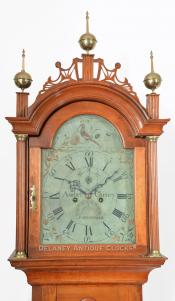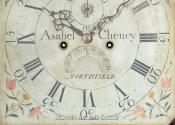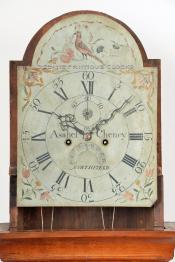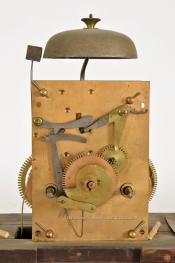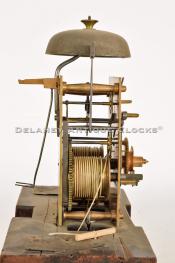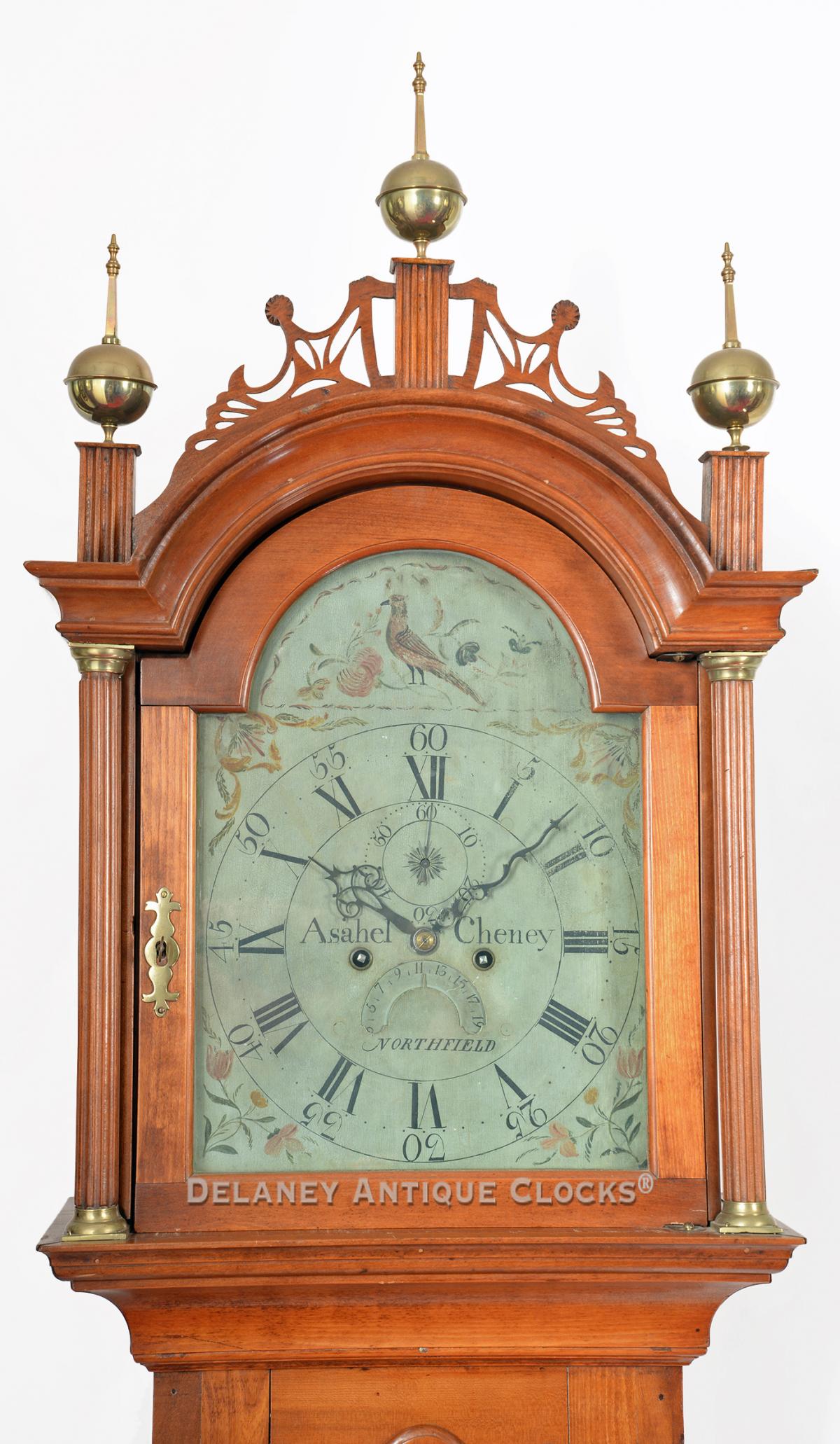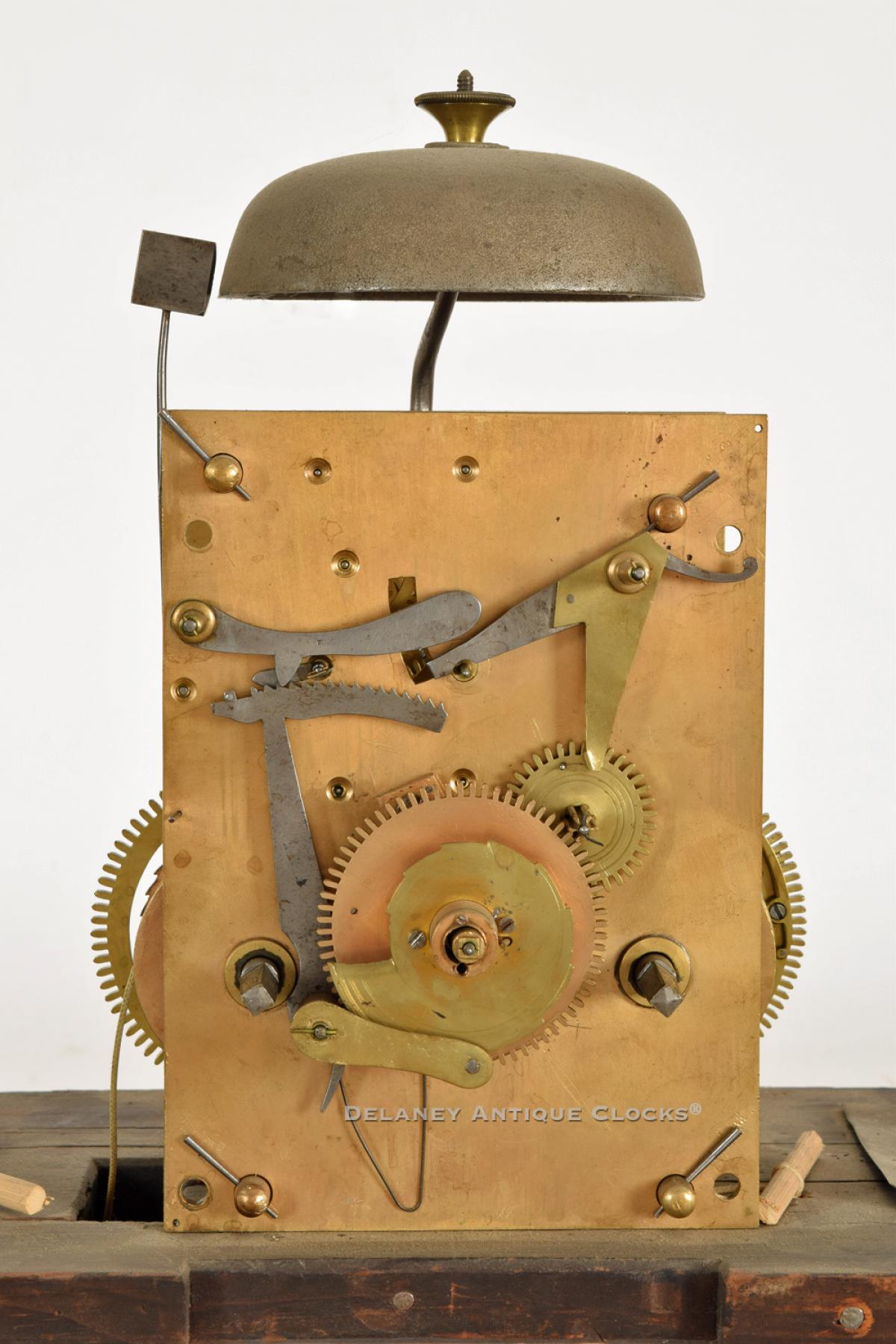Asahel Cheney of Hartford, CT, Northfield, MA, Putney, Windsor, and Royalton, VT. This fine example was made in Northfield, MA. The Northampton cabinetmaker Julius Barnard is thought to have this case. DD-160.
This fine cherry case tall clock exhibits country proportions. The light-colored finish encourages this example to stand out in a darker setting. The case is elevated on four boldly formed ogee bracket feet. These are applied to the bottom of a double-stepped molding. The waist section features a shaped waist door that is trimmed with a simple molded edge. The shape of the top of this door is distinctive. It has been found on several other clock cases associated with the Northfield cabinetmaker Julius Barnard. Fluted quarter columns flank the waist door and are fitted into the corners of the waist. These terminate at both ends in brass quarter capitals. The bonnet supports a variation of a New England-style pierce fretwork pattern. This pattern includes three fluted chimneys or final plinths, each supporting a brass ball and spike finial. The free-standing bonnet columns are also fluted and are mounted in brass capitals. Glazed tombstone-shaped side lights are cut into the side panels of the hood. The arched bonnet door opens to access the dial.
This is a locally painted iron dial. A yet-identified itinerate artist painted it. The artwork demonstrates a folk art feel. The floral patterns and the bird centered in the arch are painted in a free-flowing hand. The design is loose compared to the artwork produced in Birmingham, England. This dial features a traditionally formatted time ring. Roman-style hour numerals mark each of the twelve hours, and large Arabic numerals mark each five-minute marker up to sixty. The nicely formatted steel hands indicate the time. The calendar window is located below the center arbor. Here the date of the month is indicated on a disk designed to rotate. A subsidiary seconds dial is located above the center arbor. The Clockmaker's name and working location are boldly signed across the dial's center.
The time and strike movement is constructed in brass. This movement is designed to run for eight days on a full wind. It is good quality. It is weight driven and will strike each hour on a cast iron bell. Please note the bulbous or "Cigar" shaped posts that support the plates.
Today, a small number of tall clock cases are currently known that are attributed to Barnard, the cabinetmaker. Two of these are very similar to this one. The first is a clock that we owned. A second example is a clock pictured in Fales's book, The Furniture of Historic Deerfield, on page 264. This clock shares a very similar case which is credited to have been made by Julius Barnard. Julius Barnard trained under Eliphalet Chapin (1741-1807) of East Windsor, Connecticut. He moved up to Northampton and set up his cabinet shop. So naturally, much of his furniture exhibits a strong Chapin influence. The Williams and Billings families of Hatfield and Deerfield, MA, once owned the clock pictured in Fales's book. A third example can be found pictured in the Sack Volumes, No. 2, page 303. This clock is now reported to be in The Ford Museum. It differs significantly in case form.
This clock is approximately 7 feet 5 inches tall and was made circa 1790.
Inventory number DD-160.
Asahel Cheney was born about 1767 in East Hartford, Connecticut, and died in Royalton, Vermont, on October 31, 1819. He was the oldest son of the Hartford clockmaker Benjamin Cheney and Deborah Olcott. Many examples of Benjamin’s work have been recorded. A large number of them have movement constructed of heavy wooden gearing. Asahel and his two brothers, Martin and Russell, were most likely trained by their father. A clock that is in the Mabel Brady Garvin Collection at Yale University features an engraved brass dial and wooden geared movement that is signed, “Asahel Cheney / E. HARTFORD.” This clock is pictured in CONNECTICUT CLOCKMAKERS OF THE EIGHTEENTH CENTURY, written by Penrose R. Hoopes. By 1790, Asahel had moved to Northfield, Massachusetts, and was a property owner. He lived in what is now known as the Joseph Byrt house. Here he continued to manufacture mostly tall case clocks. We have owned several signed Northfield examples over the years featuring wooden and brass constructed movements. A second fine example can also be found in the Mabel Brady Garvin Collection at Yale University. This second clock is signed “Northfield.”
By the mid-1790s, Asahel moved to Windham County, Vermont, to the town of Putney. A shelf clock in the Henry Ford Museum collection is signed on the engraved brass kidney-shaped dial, “Asahel Cheney / Putney.” From this clock, we speculate that Asahel trained his brother Martin in the clockmaking trade. On the seat board of this clock, it is inscribed, “This clock was made by Martin Cheney.”
Soon after 1800, the brothers parted company. In 1806, Asahel moved to Royalton, VT, and purchased a store with Mr. Fessenden. He sells out his share and moves to Rochester only to return to Royalton. His name is listed in a land transaction in the town of Royalton, Vermont, in November of 1809. He purchased a shop and some land located near the Hotel from David Waller. In Royalton, he is reported to have had the clockmaker Jacob Kimball working with him. In 1818, he purchased the Gilbert Tavern. He died suddenly of apoplexy. He had a Masonic Funeral.


